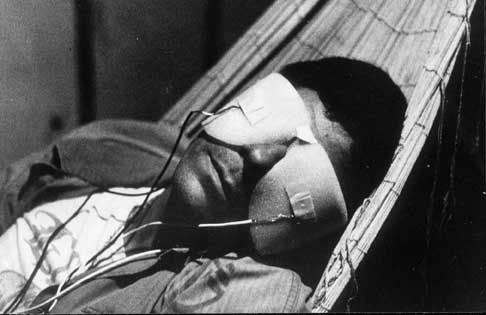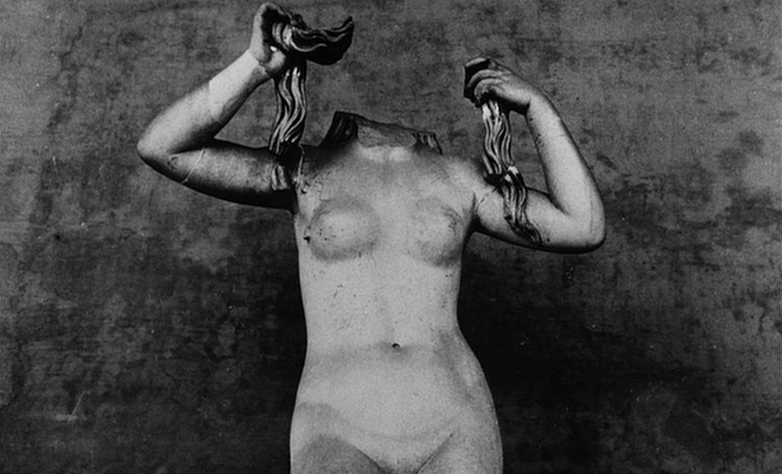 |
| figure 1. La Jetée Movie Poster |
The fall of a body starts the French black and white film off dramatically, and whilst this feeling is not felt until the end sequence it does well to end the short film unequivocally. At only 28 minutes long,
La Jetée is composed of still shots - all except one. Ironically, the most “still” of shots is the only that is shot in motion-picture. An extremely honest and simple film described as
“a minimalist masterpiece affording us an all-too-rare glimpse at the paradoxes and complexities of perception and the subconscious.” (Sellars, 2005) but only if we choose to. The described complexities can go further and manifest into concepts of time if you so wish to.
Whilst
The Jetée can be considered a Sci-fi film it is not only restricted to that genre. With the very simple addition of a romantic interest
La Jetée turns into a rather shallowly simple short-story about a man seeking a woman who he cannot get off his mind. In order to do this the man complies with a group of mad-scientist-like men running experiments on survivors of an explosion in Paris caused by war. Making the most of a bad situation he almost blindly searches out and finds the woman he was seeking. It is the plot of almost every story and would not be as conceivable as it is without the as equally sci-fi and otherworldly approach
La Jetée takes.
With 28 minutes of footage
“The Man” and
“The Woman” are less characters meant for fully-fleshed out and developed meaning but more so to act as relatable cut-outs for whoever will watch
The Jetée. - Until the Sci-fi aspects of the still-comprised film start to take over. Their situation is unique in a sense that no-one in reality will (or who knows !) come across being forced foam pieces over their eyes and having to travel back in time to find their hope-to-be sweetheart.
 |
| figure 2. Time-Travel set-up with foam goggle-eyes. |
Visually, La
Jetée is a unique choice of format for the time. From the start of the 1900’s film was constantly being pushed to producer longer films, better visuals and sweeping pan-shots meant to absolutely stun the audience. Around the same time as
La Jetée,
2001: A Space Odyssey (1968),
Psycho (1960) and
To Kill a Mockingbird (1962) were all notable films of grandiose effects or story. - Each scene carefully considered. This is the case with
La Jetée but the decision to create the 28 minute film comprised completely of stills must have been a strong decisive “push” for it from Chris Maker; director, cinematographer and screenwriter. A direct link between the use of stills and memory like a set of “snapshots” is apparent..
“As the man remembers his past, and the woman, he relives it – never really sure if he is sent or if he is dreaming – one snapshot literally coming alive with his subjective colouring.” (Sellars, 2005) The choice of format was purposeful and does a lot of work leaving holes that something shot one-hundred percent in moving-picture would automatically fill in. Whilst it is in black and white the film does not try to use artistic premise, skills or knowledge from the Film Noir 40’s and 50’s and instead provides an “Art-house” variation. Lighting is considered to emphasize a face, but
La Jetée holds a carefulness for the face rather than an overall setting in each frame. Often, the people considered evil will have lighting to make the domes of their eyes appear black and reveal the skeletal structure underneath their skin compared to the woman where everything is much softer and round. But it is in the environment around the man and woman that start to give clues into the theories of time and how we perceive it..
Technicals aside
La Jetée’s visual style comes off much more prevalent. The foam covering of the man’s eyes that look like enlarged goggles in the shape of an infinite sign, or statues with missing parts, chips and imperfections.
(figure 3) - Simple mechanisms that are only seen for a few seconds but once thought into more detail hold true to the film’s idea of time and human nature. - We will only be able to ever see what is there and as such we focus on it. As British Film Scholar Janet Harbord notes
“We are instructed to look at the fragments that endure, at the partial nature of things that survive over time” (Harbord and Marker, 2009) and with this you start to understand much more that there are subtle pieces of imagery that make up
La Jetée even though it is not pushed in your face. It is extremely ironic that as the man travels back in time to revisit (and relive…) a woman he remembers, they end up in a taxidermy museum filled with animals that look alive but have been seemingly “frozen” in time in a state they were remembered for being.
 |
| figure 3. Example of statue with missing head. |
Perhaps the most striking piece of imagery used in La Jetée is the figure with an elongated arm jarred in a strange position. (figure 4.) The mysterious figure is dressed in normal, but overall dark clothes. It stands between the man and the woman and ultimately acts as a marker of death for the man. - Immediately bringing us back to the beginning where we see the fall of a body. - It was the man’s. It is disappointing however, that this suddenly creepy and demented figure pop out from nowhere towards the end. When the film ends it leaves a bad taste in your mouth; not because La Jetée ends badly but because imagery used for the grim-reaper like figure or the people from the future did not get fully explored. At only 28 minutes long the film starts becoming it’s own with true sci-fi elements emerging only to be stopped. As a character-based film La Jetée works very well as both having a simple, clear story under a short time limit but also introducing sci-fi elements into a love-interest involved film. It is no wonder that many, many films have stuck to this template in recent years as it is an extremely safe option now that films just like La Jetée had come first and achieved it in a much shorter space of time.
 |
| figure 4. Grim Reaper styled figure. |
Bibliography
Harbord, J. and Marker, C. (2009). Chris Marker, La jetée. London: Afterall Books.
Sellars, S. (2005). Ballardian » Retrospecto: La Jetée. [online] Ballardian.com. Available at: http://www.ballardian.com/la-jetee [Accessed 13 Jan. 2015].
Illustration List
Marker, C. (1962). [image] Available at: http://payload.cargocollective.com/1/1/41869/512158/4332176611_1a3a865b5e_b.jpg [Accessed 13 Jan. 2015].
Marker, C. (1962). [image] Available at: http://24.media.tumblr.com/tumblr_m54acfTOTm1qb83nho1_1280.png [Accessed 13 Jan. 2015].
Marker, C. (1962). [image] Available at: http://www.fsf.vu.lt/dokumentai/naujienos/2014/Kadras_i%C5%A1_filmo_La_Jetee._Meno_avilio_archyvas.jpg [Accessed 13 Jan. 2015].
Marker, C. (1962). [image] Available at: http://s3.amazonaws.com/criterion-production/product_images/1505-b2cd0ce10ae50ccaddf336cd797dbd2c/LJ_SS_Page_Still_original.jpg [Accessed 13 Jan. 2015].






.png)











